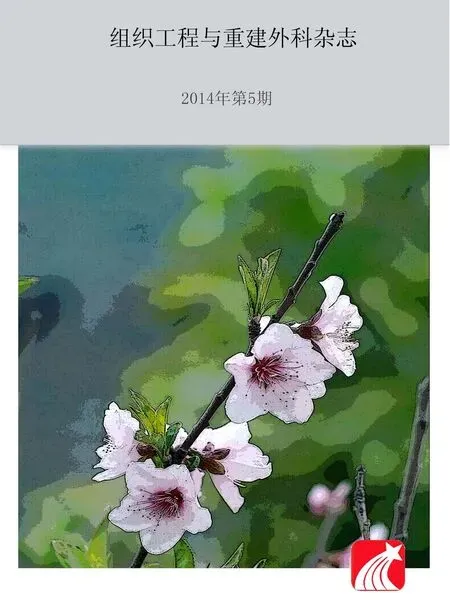柠檬酸酸蚀后再植牙根表面的脱矿研究
朱文婷 汪 俊 岑 莲
柠檬酸酸蚀后再植牙根表面的脱矿研究
朱文婷 汪 俊 岑 莲
目的研究不同脱矿方法酸蚀牙根后,根面形貌的变化及胶原纤维暴露面积,探索牙根再植的最佳存活条件。方法收集离体狗牙,制备5 mm×5 mm大小的根片,随机分为7组:A组未经酸蚀处理,即空白对照组;B组采用30%柠檬酸浸泡处理1 h;其余5组使用浸有30%柠檬酸溶液的小棉球擦拭牙面,时间分别为3 min、5 min、10 min、20 min和30 min,设为C-3、C-5、C-10、C-20、C-30组。处理后样本扫描电镜观察根面微观形貌。热重分析仪SDT检测酸蚀处理对牙根无机物损耗的影响。在根面接种骨髓间充质细胞,观察细胞早期附着及增殖情况。结果未处理的根面可见明显玷污层,经柠檬酸浸泡1 h后根表面光滑,未见有暴露的胶原纤维。而使用擦拭方法处理的根面不仅能去除玷污层,而且能暴露胶原纤维,且随擦拭时间的变化暴露的胶原量也有明显差异。C-5组根面暴露的胶原面积高于C-3组,而处理时间超过10 min的根面可以发现牙骨质的大面积脱矿,牙本质小管暴露,且胶原纤维也随着牙骨质的剥脱而破坏。此外,接种在酸蚀根面的细胞附着形态较好,增殖活性强于未处理根面。结论柠檬酸根面擦拭处理5 min为理想的再植牙根表面处理方式。
柠檬酸根面处理细胞定植
全脱位性外伤患牙脱离牙槽窝时间过长、再植被延时,根面残留的死细胞及口内外环境中的污染物形成的玷污层影响了再植后牙周附着的形成及牙周组织愈合[1]。牙根面的适度脱矿能去除影响牙周附着形成的玷污层,更重要的是这种化学处理方式对于改善根面的生物相容性具有重要意义[2-4]。细胞外基质的结构能影响细胞的一系列生物学行为参数,包括形态、黏附及其基因表达[5-7]。通过化学制剂对根面的直接改性可提高参与牙周组织再生细胞在根面的吸附和增殖能力,从而促进牙周组织再生[8-9]。
根面酸蚀处理剂种类众多,30%柠檬酸有效可去除玷污层,应用较广泛[10-16],但使用方法及处理时间仍缺乏详细的论证。本实验选用常用的有效根面酸蚀处理剂30%柠檬酸对根面进行酸蚀处理,比较处理的不同方式及不同时间,对去除玷污层的效果、根面胶原纤维暴露的程度,及其对细胞早期黏附与增殖的影响,寻找适于修复细胞定植的处理方法与时间,利于后继的组织修复。
1 材料和方法
1.1 实验试剂与设备
柠檬酸(国药集团化学试剂有限公司,上海)、CCK8试剂盒(同仁化学研究所,日本)、场发射扫描电镜FE-SEM(FEI公司,美国)、纯水系统(Millipore公司,美国)、恒温CO2细胞培养箱(Thermo Scientific,美国)、激光共聚焦显微镜(Nikon,日本)、热重分析仪(TA公司,美国)
1.2 方法
1.2.1 样本的制备
收集比格犬磨牙,去净牙周膜,取牙根中1/3,磨成5 mm×5 mm大小牙片,标记实验面,去离子水冲洗浸泡。
1.2.2 试剂的配置
常温下新鲜配制质量分数30%的柠檬酸备用。
1.2.3 牙根面的酸蚀处理及根面形貌观察
随机分为7组(n=5)。第一组作为空白对照组,不作任何处理,为A组;第二组浸泡于30%柠檬酸溶液1 h,为B组;其余5组,使用浸有30%柠檬酸溶液的小棉球擦拭牙面,时间分别为3 min、5 min、10 min、20 min、30 min,分别为C-3、C-5、C-10、C-20、C-30组。棉球30 sec更换一次,处理后样本用去离子水冲洗浸泡,2.5%戊二醛固定,乙醇梯度脱水,真空抽气,喷金,扫描电镜观察根面形貌。
1.2.4 检测酸蚀处理对牙根无机物损耗的影响
使用热重分析仪TGA检测A组及C-5组根片的无机物含量,分析酸蚀处理对牙根无机物损耗的影响。
1.2.5 根面微观形貌对细胞增殖的影响
根片消毒后,置于96孔培养板内,将细胞悬液浓度调整为2 000个/孔,接种在A组及C-5组根片上,37℃、5%CO2、饱和湿度下孵育,隔天换液,接种后第1、4、7天,取出根片,放入新培养孔中,加入100μL DMEM及10μL CCK-8试剂,避光孵育2 h,酶标仪测定450 nm处的吸光度。
1.2.6 骨髓间充质细胞在酸蚀牙根面的黏附情况
将第3代犬骨髓间充质细胞以2×104的细胞密度接种至C-5组的牙齿根面,培养24 h后洗掉培养液,PBS清洗3次,随后用2.5%戊二醛固定3 h。PBS清洗5 min,重复3次。乙醇梯度脱水,真空抽气,喷金,扫描电镜观察根片。
1.2.7 统计学分析
以SAS8.02统计软件进行数据分析,相关指标以x±s表示,单因素方差分析组间差异,P<0.05为差异有统计学意义。
2 结果
2.1 根面微观形貌观察
扫描电镜显示未处理牙根表面(A组)可见大量细小颗粒黏附,形成均匀的玷污层(图1a);经柠檬酸浸泡1 h后(B组)根表面光滑干净,但未见暴露的胶原纤维(图1b)。
擦拭组根面可见不同程度的胶原纤维暴露,C-3和C-5组根面胶原暴露较充分(图2a、2b),而擦拭超过10 min的根面已经可见牙骨质的大面积脱矿及牙本质小管的暴露,且纤维结构随着牙骨质的大量脱矿而受到不同程度的破坏(图2d、2e、2f)。
从C-3组和C-5组根面随机选取5个区域,以Photoshop CS 5.0计算胶原所占面积比率,结果显示C-5组根面暴露的胶原面积为84.61%±2.46%,高于C-3组的61.51%±5.56%(P<0.05)。因此,相较3 min的处理时间,5 min的处理时间对根面胶原结构的暴露更有效(图2c)。
2.2 酸蚀处理对牙根无机物损耗的影响
脱位牙再植后,牙骨质的无机物能一定程度阻止根面的进行性吸收,因此在暴露胶原的基础上应能尽量减少牙骨质无机物的损耗。TGA检测显示酸蚀处理后的牙根其无机物成分减少,但是C-5组无机物成分仍然维持在70%左右(图3)。
2.3 根面微观形貌对细胞在根面增殖的影响
通过CCK8法检测骨髓间充质细胞在A组及C-5组根面上培养1、4、7 d后的增殖活性(图4),培养1 d后,间充质细胞在A组和C-5组根片表面的增殖活性略有不同,但没有统计学意义;培养4 d、7 d后发现,C-5组根片表面的增殖活性显著高于A组根片表面(P<0.05)。
2.4 间充质细胞在酸蚀根面的黏附情况
骨髓间充质细胞在A组和C-5组根片表面培养24 h后发现,细胞在A组根面铺着平坦,形态不饱满,而在C-5组根面附着多呈两极或多极生长,形态丰满,突起伸展充分,分泌基质活跃(图5)。

图1 扫描电镜观察根面微观表面形貌图(10 000×)Fig.1 SEM micrographs of morphology on the surface of root (10 000×)

图2 扫描电镜观察根面经柠檬酸擦拭处理3 min(a)、5 min(b)、10 min(d)、20 min(e)、30 min(f)的牙根表面微观表面形貌图;c为酸蚀处理min及5 min后根面胶原暴露面积比率的比较(10 000×)Fig.2 SEM micrographs of morphology on the surface of root treated with cotton pellets soaked in the 30%citric acid solution at the time points of 3min(a),5min(b),10min(d),20min(e)and 30min (f)separately.c.comparison of collagen exposure rate between the treatment of 3min and 5min.(10 000×)

图3 A组和C-5组样本的DSC-TGA比较Fig.3 Comparison of DSC-TGA result between group A and group C-5

图4 CCK8检测骨髓间充质细胞在不同根面增殖情况Fig.4 Detection ofcellproliferation on the different rootsurface

图5 扫描电镜观察骨髓间充质细胞接种至A组和C-5组酸蚀根面24 h后的形态(10 000×)Fig.5 SEM observation of the root surface after seeding BMSCs for 24 hours in group A and group C-5(10 000×)
3 讨论
发生全脱位性牙外伤时,患牙脱离牙槽窝,根面残留的死细胞及口内外环境中的污染物形成的玷污层是一道物理性屏障,影响了修复细胞的附着和增殖,一定程度上阻碍了再植后牙周附着的形成及牙周组织愈合[16]。许多学者对如何有效去除根面玷污层进行了深入研究,目前学者们比较推崇的方法是使用酸蚀剂对牙根面进行酸蚀处理。体外实验结果显示:牙根面的适度脱矿能去除影响牙周附着形成的玷污层,与未酸蚀处理的牙根相比,牙根酸蚀处理后暴露的胶原纤维能更有效地促进纤维蛋白凝块形成,而纤维蛋白凝块正是早期创伤修复的一个决定性因素[17-19]。且相关蛋白聚糖的暴露,使血浆纤维蛋白及细胞生长因子易于与其亲和,营造利于修复细胞附着、增殖的微环境。引导促进细胞和微环境之间的“交流”,形成新的牙周组织[20-23]。
根面酸蚀处理剂的种类众多,柠檬酸因其有效的去污能力得到广泛应用[24-26],本实验使用30%的柠檬酸对根面进行擦拭处理,寻求牙根面去除玷污层及暴露根面胶原纤维基质的最适时间,研究其对细胞因子的吸附能力及对细胞早期黏附生长的影响。实验结果发现:浸泡和擦拭两种处理方式都能有效去除根面玷污层,但仅用酸浸泡的根面不能暴露胶原纤维,根面擦拭处理的方法能使纤维结构暴露,而处理时间的长短会影响根面形貌和胶原纤维的暴露程度以及牙本质层的完整度。柠檬酸根面擦拭处理5分钟,能使根面的胶原面积得到较好地暴露又能保持牙本质层不受影响,且无机物相对含量仍保持在相对高位,为70%。通过体外细胞接种实验进一步证实了优化处理后的根面更利于细胞的早期定植。但体内实验的安全性及对细胞的影响仍需进行进一步的研究。
[1]Blomlöf JP,Lindskog S.Periodontal tissue-vitality after different etching modalities[J].J Clin Periodontol,1995,22(6):464-468.
[2]Crigger M,Renvert S,Bogle G.The effect of topical citric acid application of surgically exposed periodontal attachment[J].J Periodont Res,1983,18(3):303-305.
[3]Sampaio JEC,Rached RSGA,Pilatti GL,et al.Effectiveness of EDTA and EDTA-T brushing on the removal of root surface smear layer[J].Pesqui Odontol Bras,2003,17(4):319-325.
[4]Daryabegi P,Pameijer CH,Ruben MP.Topography of root surfaces treated in vitro with citric acid,elastase and hyaluronidase[J].J Periodontol,1981,52(12):736-742.
[5]Tan W,Desai TA.Microfluidic patterning of cells in extracellular matrix biopolymers:effects of channel size,cell type,and matrix composition on pattern integrity[J].Tissue Eng,2003,9(2):255-267.
[6]Norman JJ,Desai TA.Methodsfor fabrication of nanoscale topography for tissue engineering scaffolds[J].Ann Biomed Eng,2006, 34(1):89-101.
[7]Dangaria SJ,Ito Y,Yin L,et al.Apatite microtopographies instruct signaling tapestries for progenitor-driven new attachment of teeth[J].Tissue Eng Part A,2011,17(3-4):279-290.
[8]Roxanne AL,Timothy MB.Periodontal regeneration:root surface demineralization[J].Periodontol,2000,1(1):54-68.
[9]Crigger M,Renvert S,Bogle G.The effect of topical citric acid application of surgically exposed periodontal attachment[J].J Periodont Res,1983,18(3):303-305.
[10]Amaral NG,Rezende ML,Hirata F,et al.Comparison among four commonly used demineralizing agents for root conditioning.A scanning electron microscopy[J].J Appl Oral Sci,2011,19(5): 475-479.
[11]Hanes P,Polson A,Frederick T.Citric acid treatmentofperiodontitisaffected cementum.A scanning electron microscopic study[J].J Clin Periodontol,1991,18(7):567-575.
[12]Labahn R,Fahrenbach WH,Clark SM,et al.Root dentin morphology after different modes of citric acid and tetracycline hydrochloride conditioning[J].J Periodontol,1992,63(4):303-309.
[13]Sterret JD,Murphy HJ.Citric acid burnishing of dentinal root surfaces.A scanning electron microscopy report[J].J Clin Periodontol,1989,16(2):98-104.
[14]Sterrett JD,Dhillon M,Murphy HJ.Citric acid demineralization of cementum and dentin:the effect of application pressure[J].J Clin Periodontoi,1995,22:434-441.
[15]Crigger M,Bogle G,Nilveus R,et al.The effect of topical citric acid application on the healing of experimental furcation defects in dogs[J].J Periodontal Res,1978,13(6):538-549.
[16]Sampaio JEC,Rached RSGA,Pilatti GL,et al.Effectiveness of EDTA and EDTA-T brushing on the removal of root surface smear layer[J].Pesqui Odontol Bras,2003,17(4):319-325.
[17]Polson AM,Proye MP.Fibrin linkage:a precursorfornew attachment [J].J Periodontol,1983,54(3):441-454.
[18]Lowenguth RA,Blieden TM.Periodontal regeneration:rootsurface demineralization[J].Periodontol 2000,1993,1(1):54-68.
[19]Crigger M,Bogle G,Nilveus R,et al.The effect of topical citric acid application on the healing of experimental furcation defects in dogs[J].J Periodontal Res,1978,13(6):538-549.
[20]Hanes PJ,Polson AM,Frederick T.Citric acid treatment of periodontitis-affected cementum.A scanning electron microscopic study[J].J Clin Periodontol,1991,18(7):567-575.
[21]Hanes PJ,Polson AM.Cell and fiber attachment to demineralized cementum from normal root surfaces[J].J Periodontol,1989,60(4): 188-198.
[22]Craig MR,Max C,Knut A.Healing of periodontal connective tissues following surgical wounding and application of citric acid in dogs[J].J Periodontal Res,1980,15(3):314-327.
[23]Pettersson EC,Aukhii I.Citric acid conditioning of roots affects guided tissue regeneration in experimental periodontal wounds [J].J Periodontal Res,1986,21(5):543-552.
[24]Hanes P,Polson A,Frederick T.Citric acid treatmentofperiodontitisaffected cementum.A scanning electron microscopic study[J].J Clin Periodontol,1991,18(7):567-575.
[25]Labahn R,Fahrenbach WH,Clark SM,et al.Root dentin morphology after different modes of citric acid and tetracycline hydrochloride conditioning[J].J Periodontol,1992,63(4):303-309.
[26]Sterret JD,Murphy HJ.Citric acid burnishing of dentinal root surfaces.A scanning electron microscopy report[J].J Clin Periodontol,1989,16(2):98-104.
The Texture of Replanted Root Surface and Early Cell Colonization After Citric Acid Demineralization
ZHU Wenting1,WANG Jun1,CEN Lian2,3.1 Department of Pediatric Dentistry,Shanghai Ninth People's Hospital,Shanghai Jiaotong University School of Medicine,Shanghai Key Laboratory of Stomatology,Shanghai 200011,China;2 National Tissue Engineering Center of China,Shanghai 200241,China;3 School of Chemical Engineering,East China University of Science and Technology,Shanghai 200237,China.Corresponding author:WANG Jun(E-mail:wangjun202@hotmail.com).
ObjectiveTo investigate the texture of root surface and collagen fiber exposure after etching with different modes of citric acid,and to explore the best condition for root replantation.MethodsRoot pieces(5 mm×5 mm)were prepared from molars of beagle dog and randomly divided into seven groups.Group A was treated as negative control,and root pieces in group B were soaking in 30%citric acid solution for 1 hour.The root surfaces of remaining five groups were rubbed with cotton pellets soaked in the 30%citric acid solution for 3 min,5 min,10 min,20 min and 30 min separately. Scanning electron microscopy was used to observe the presence of smear layer and the area of exposed collagen fibers. Inorganic loss after acid etching was detected by thermo gravimetric analyzer.BMSCs were seeded and cultured for 24 hour on the surface of citric acid-etched root.The condition of cell proliferation was tested by Cell Counting Kit-8.ResultsSmear layer was observed in group A.The root surface in group B was smooth,without any exposed collagen fibers.Collagen fibers exposure was observed in group C with no smear layer.The exposed amount of collagen was different according to the different processing time.The exposed amount of collagen in C-5 group was higher than in C-3 group,and the processing time of more than 10 minutes were appeared to remove not only the mineral component but also the collagenous matrix.Cell adhesion and cell proliferation in etched group were better than in control group.ConclusionThe root surfacerubbed with cotton pellets soaked in the 30%citric acid solution for 5 min seems to be an ideal root surface conditioning method.
Citric acid;Root surface conditioning;Cell colonization
Q813.1+1
A
1673-0364(2014)05-0259-04
2014年7月22日;修复日期:2014年9月7日)
10.3969/j.issn.1673-0364.2014.05.006
国家重点基础研究发展计划(“973”项目,2010CB944804);上海市科学技术委员会医学引导项目(124119b0101)。
200011上海市上海交通大学医学院附属第九人民医院儿童口腔科,上海口腔医学重点实验室(朱文婷,汪俊);200241上海市组织工程国家工程研究中心(岑莲);200237上海市华东理工大学化工学院(岑莲)。
汪俊(E-mail:wangjun202@hotmail.com)。

